2023.08.02.41
Files > Volume 8 > Vol 8 No 2 2023
Effect of gibberellic acid on germination and seedling growth of Soybean (Glycine max L. Merrill)
1 Dep. of Field Crops, College of Agriculture, Tikrit Univ., Salah Al-Din, Iraq; [email protected]
* Correspondence: [email protected]; Tel.: +9647831752951
Available from: http://dx.doi.org/10.21931/RB/2023.08.02.41
ABSTRACT
The germination percentage of Soybeans is susceptible and affected by many external and internal factors. Screening of three varieties of soybeans (Shimaa, Industrial2, and M103) during laboratory germination and field emergence was conducted to identify varieties with superior performance under four concentrations of gibberellic acid (0, 75, 150, 225 ppm). Experiments were conducted in Field Crops Dept./College of Agriculture/Tikrit University. Results showed significant differences between gibberellic acid concentrations, varieties, and interactions for all studied traits. Seeds treated with a concentration of (150 ppm) were superior in laboratory germination and field emergence percentages, averaging 92.58% and 59.08%, respectively. Varieties of Shimaa and M103 were superior in giving the highest germination percentage in the laboratory, 87.5% and 87.94%, respectively. The Shimaa variety outperformed, giving the highest field emergence percentage, 58.00%. Interaction of Shaima x150 ppm (GA3) showed the highest laboratory germination percentage and highest field emergence percentage, 96.75% and 63.25%, respectively. These Results indicate that the use of gibberellic acid significantly increased the germination rate of soybean seeds and field emergence rate due to the role of this hormone in stimulating the synthesis of enzymes necessary for germination and seedling vigor.
Keywords: Soybean; GA3; Seed germination percentage; Field emergence percentage.
INTRODUCTION
Soybean (Glycine max [L.] Merr.) is one of the most important industrial crops in the world because it is the only crop whose seed contains all the essential amino acids for human and animal growth1,2. The seed of this crop is an essential source of protein and oil of excellent and desirable quality with high economic value in the world3,4. Soybean seeds contain 40% protein, 20% oil, 33% carbohydrates, and many nutritional minerals5,6. The soybean crop is leguminous, so its cultivation improves the properties of the soil and increases soil fertility by fixing atmospheric nitrogen in the soil by root nodule bacteria and supplying the plant with its nitrogen needs7. The soybean crop is cultivated in large areas of the world. In 2021, Brazil took first place in the world, with production reaching 36% of the global production of this crop, followed by the United States of America with 35%. The cultivated area of this crop was 130.18 million hectares, and the production rate was 349.37 million metric tons in the world8. In Iraq, the cultivation of this crop began in the mid-nineteenth century to meet the country's needs of this crop, but its production suffered several problems. The most important one is the shrinkage of seeds due to the high temperature and drought in Iraq, which negatively affects the quality of seeds and impacts the percentage of germination and seedling emergence9.
The germination percentage is affected by many factors, including external factors, such as climatic or internal factors. The most important are the genetic composition, vitality of the seed, its strength, and its enzymatic and hormonal system. The law percentages of seed germination and field emergence affect growth stages and productivity of Soybeans in the field10. The seed begins to germinate when the ideal germination conditions are provided, such as moisture, temperature, light, and the active enzymatic system responsible for the construction and demolition processes to provide the embryo with the necessary food for the germination process. Plant hormones, especially gibberellins, found in the seeds are responsible for the functioning of this enzyme system. Plant hormones, including gibberellins, play an essential and significant role in plant growth and development, such as seed germination, stem elongation, bud growth, sexual expression, and flower and seed development11,12,13. Many researchers have studied the effect of gibberellic acid on the germination of seeds of many crops, including Soybeans. Also, 14 indicated that the use of the growth regulator gibberellic acid (GA3) significantly increased the germination rate of soybean seeds due to the role of this hormone in stimulating the synthesis of enzymes necessary for germination. The role of this plant growth is not limited to seed germination; 15 found that using gibberellic acid led to an increase in vegetative growth and leaf area and, thus, the total yield of the soybean crop. The same result was founded by 16,17. This study aims to treat the seeds of three soybean varieties with four concentrations of gibberellic acid to determine its effect on Soybean germination and seedling growth, the best concentration for each cultivar, and their interaction.
MATERIALS AND METHODS
A laboratory experiment was carried out in the laboratory of the Department of Field Crops/College of Agriculture/Tikrit University to study the effect of soaking the seeds of three varieties of soybeans (Shimaa, Industrial 2, and M103) with four concentrations of gibberellic acid (GA3), which are 0, 75, 150, and 225 ppm. Gibberellic acid (GA3) concentrations were prepared by dissolving 1 gm of gibberellic acid in distilled water with continuous stirring and completing the solution to a liter by adding distilled water. The required concentrations (75, 150 and 225 ppm) were prepared from the standard solution according to the following equation:
C1 V1=C2 V2
Seeds were disinfested with 1% sodium hypochlorite (NaClO) for 3 minutes, rinsed thrice with sterile distilled water, then air-dried. From each variety, uniform seeds in size and shape were selected for the experiment. Soybean seeds of each variety were pre-soaked in GA3 solutions (0, 75, 150 and 225 ppm) for 24 hours. After that, the solutions were dropped, and the seeds were air-dried.
Laboratory Experiment
Seeds treated with different concentrations of gibberellic acid were grown in Petri dishes with a diameter of (13.8 cm). In each plate, 10 seeds were placed on 2 layers of Whatman filter paper for each treatment. Then seeds were rinsed with 10 ml of distilled water. The experiment used a completely randomized design (C. R. D.) with three replications for each treatment. The germination process was carried out in the incubator at a temperature of 25 ± 2 for ten days. After that, the number of natural seedlings was only counted18. The following equation measured the percentage of germination:
The percentage of germination = (the number of normal seedlings/Total number of seeds) x 100
Field Experiment
Seeds treated with different concentrations of gibberellic acid were planted in pots (5 L) filled with gypsum soil to calculate the field emergence percentage. Ten seeds were planted in each pot. The experiment was conducted in the field using a randomized complete block design (R. C. B. D) with three replications (pots) for each treatment. Pots were watered with water immediately after planting. After 15 days, the field emergence percentage was calculated according to the following equation:
Field emergence percentage % = (Number of seedlings emerging/Total number of seeds) x 100
Study data were statistically analyzed as a CRD and RCBD using PROC MEANS and PROC GLM in SAS (Version 9.4, SAS Institute, 2011, Cary, NC)19. Means were compared using Fisher's least significant difference (LSD) at α = 0.05. Data were graphed using SigmaPlot version 13 (Systat Software).
RESULTS
Percentage of germination in a laboratory test experiment
Table 1 shows the average germination percentage of three soybean varieties treated with four concentrations of gibberellic acid in the laboratory germination test experiment. The results show a significant difference in the effect of gibberellic acid concentrations on the percentage of seed germination soybean varieties. Seeds treated with gibberellic acid at a concentration of 150 ppm were superior to the rest of the treatments in the percentage of germination; where this treatment gave the highest percentage of germination, which amounted to 92.58%, while the treatment of seeds with 75 ppm of gibberellic acid gave the lowest average percentage of germination reached to 77.83%, which did not differ significantly from the control treatment, which gave an average germination rate of 76.83% Figure 1.

Table 1. Effect of different concentrations of gibberellic acid (0, 75, 150, 225 ppm) on the germination percentage of seeds of three soybean varieties (Shimaa, Industrial 2 and M103) in a laboratory test experiment
Table 1 shows significant differences between the varieties in this trait. The M103 variety gave the highest germination rate of 87.94%. It did not differ significantly from the Shimaa variety, which gave a germination rate of 87.50%. In contrast, they differed significantly from the Industrial 2 variety, which gave the lowest average germination rate of 74.06% Figure 1. Gibberellic acid concentrations also showed significant differences in laboratory germination percentage of seeds of soybean varieties. The concentration of 150 ppm had the highest germination percentage, 92.58%, which was superior on all concentrations. In comparison, seeds treated with control and 75 ppm had the lowest germination percentage of germination percentage76.83% and 77.83, respectively Figure 2.
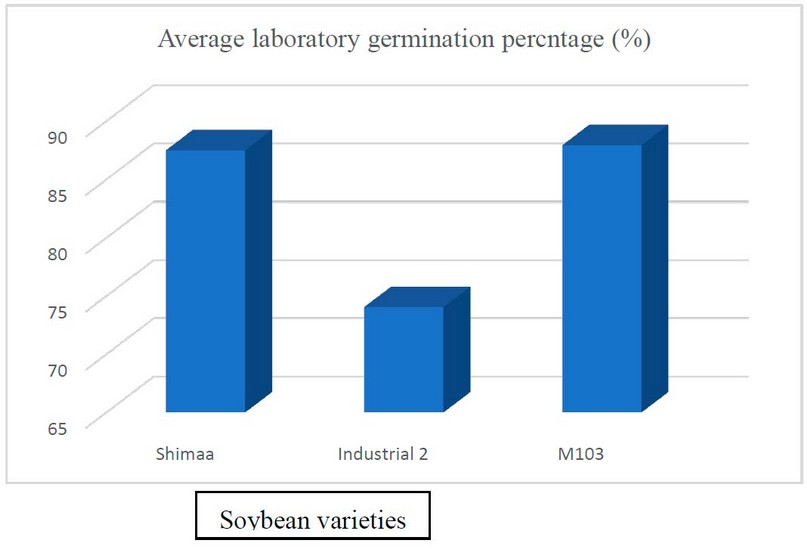
Figure 1. Average laboratory germination percentage (%) for soybean varieties
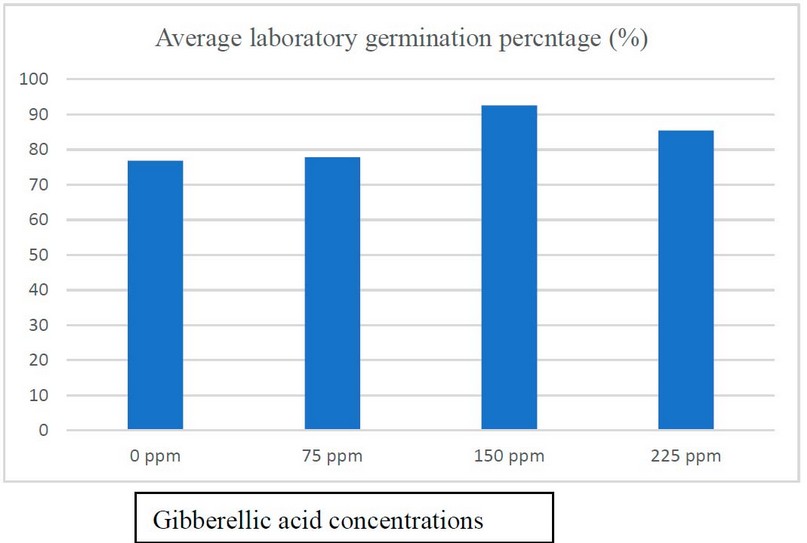
Figure 2. Average laboratory germination percentage (%) of seeds of soybean varieties treated with different concentrations of gibberellic acid.
The interaction between the Shimaa variety with a concentration of 150 ppm of gibberellic acid was superior by giving the highest germination percentage in the laboratory germination test experiment, which amounted to 96.75%. At the same time, the interaction between the Industrial 2 variety with a concentration of 75 ppm of gibberellic acid showed the lowest average germination rate, which was 65.75% Figure 3.

Figure 3. Average laboratory germination percentage (%) for the interaction between soybean varieties x gibberellic acid concentration
Percentage of field emergence in a field test experiment
Table 2 shows the average field emergence percentage of seeds of three soybean varieties treated with four concentrations of gibberellic acid in a field germination test experiment. Results showed a significant difference in the effect of gibberellic acid on the percentage of field emergence of the soybean crop varieties. Seeds treated with a concentration of 150 ppm of gibberellic acid gave the highest average of the percentage of field emergence, reaching 59.08%. In comparison, the treatment of seeds with a concentration of 75 ppm of gibberellic acid had the lowest average field emergence percentage, which amounted to 44.42%. This result is positively and significantly correlated with the percentage of laboratory germination. Seeds treated with a concentration of 150 ppm of gibberellic acid had superiority in the percentage of laboratory germination, which means that they can give natural seedlings (high field emergence percentage).

Table 2. Effect of different concentrations of gibberellic acid (0, 75, 150, 225 ppm) on the field emergence percentage % of seeds of three soybean varieties (Shimaa, Industrial 2 and M103) in a field test experiment
Also, there was a significant difference among varieties in field emergence percentage Table 2. The Shimaa variety gave the highest average field emergence percentage, which amounted to 58.00%, significantly superior to the Industrial 2 and M103 varieties. At the same time, Industrial variety gave the lowest average for the characteristic of the percentage of field emergence, which amounted to 41.38% Figure 4. The concentration of 150 ppm of gibberellic acid had the highest field emergence percentage, 59.08%, which was superior on all concentrations, while seeds treated with 75 ppm had the lowest value of emergence percentage, 44.42% Figure 5.
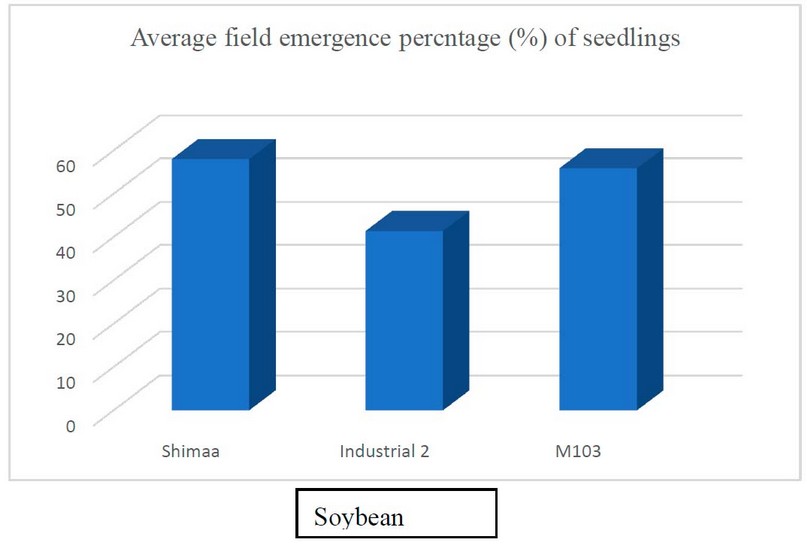
Figure 4. Average field emergence percentage (%) of seedlings of soybean varieties
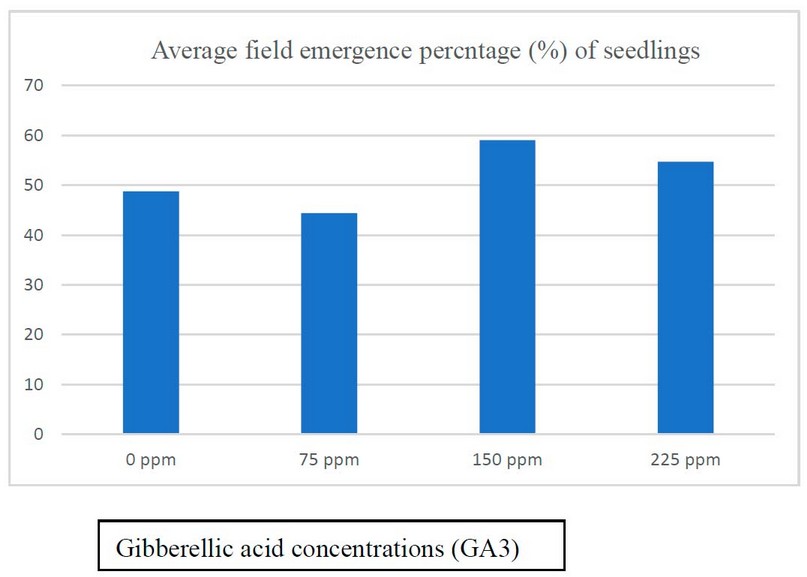
Figure 5. Average field emergence percentage (%) of seedlings of soybean varieties treated with different concentrations of gibberellic acid.
It is also clear from the results of Table 2 that there are significant differences between the averages of field emergence percentage due to the interaction effect between the concentrations of gibberellic acid and the varieties of the soybean crop. The interaction of Shimaa x 150 ppm of gibberellic acid showed the highest percentage of field emergence, which amounted to 63.25%, which did not differ significantly from the interaction of the variety M103 x 150 ppm of gibberellic acid with an average field emergence percentage of 62.50%. At the same time, the interaction between Industrial 2 variety x 75 ppm of gibberellic acid gave the lowest mean of the field emergence percentage, which amounted to 29.25% Figure 6.
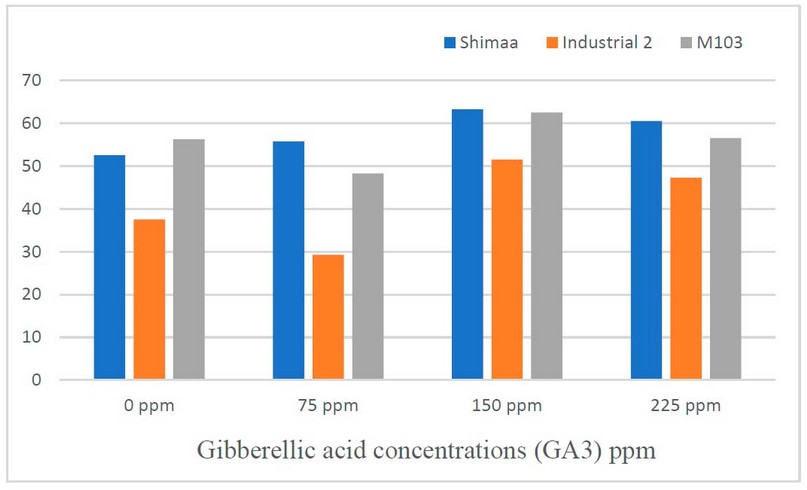
Figure 6. Average field emergence percentage (%) of seedlings for the interaction between soybean varieties x gibberellic acid concentrations.
DISCUSSION
The results show a significant difference among the effect of gibberellic acid concentrations on the percentage of seeds germination in soybean varieties; these results are consistent with the concept indicating that treating seeds with gibberellic acid improves the percentage of germination7,10,14,18,20,21,22,23. The interaction between the Shimaa variety with a concentration of 150 ppm of gibberellic acid was superior by giving the highest germination percentage in the laboratory germination test experiment. While the interaction between the Industrial 2 variety with a concentration of 75 ppm of gibberellic acid showed the lowest average germination rate, the reason of this result may be due to the effect of gibberellic acid at this concentration (150 ppm) in accelerating the germination and emergence of seedlings, which allows them to grow24,25. However, seeds treated with a concentration of 150 ppm of gibberellic acid had superiority in the percentage of laboratory germination, which means that they can give natural seedlings (high field emergence percentage). Thus, it meets the definition of AOSA seed vigor, which states that germination vigor includes those characteristics of the seed that determine the potential for rapid and uniform emergence and development of natural seedlings under a wide range of field conditions10,15,17,26,27. Moreover, the results indicate that the use of the growth regulator gibberellic acid had a significant effect on increasing the germination rate of soybean seeds and the percentage of field emergence due to the role of this hormone in stimulating the synthesis of enzymes necessary for germination and seedling vigor14,27.
CONCLUSIONS
Plant growth regulator (GA3) significantly affected all soybean varieties' seed germination and field emergence percentages. The concentration of 150 ppm of gibberellic acid gave the highest value for these traits with all varieties. There was no significant difference between Shimaa and M103 varieties in the seed germination percentage; they were superior to the Industrial 2 variety. At the same time, the Shimaa variety was superior to all varieties in the percentage of field emergence traits.
Author Contributions: Abdullah Hassan Mohammed: Conceptualization; methodology; software; validation; formal analysis; investigation; resources; data curation; writing—original draft preparation; writing—review and editing; visualization; supervision; project administration; funding acquisition.
Funding: This research received no external funding.
Acknowledgments: The author acknowledges the Department of Filed Crops/College of Agriculture at Tikrit University for supporting and providing the facilities to conduct the research. I also thank the graduate students for their support during data collection.
Conflicts of Interest: The authors declare no conflict of interest.
REFERENCES
1. Singer, W. M.; Zhang, B.; Mian, M. R.; Huang, H. Soybean amino acids in health, genetics, and evaluation. In Soybean for human consumption and animal feed. IntechOpen, 2020. https://doi.org/10.5772/intechopen.89497
2. Kudelka, W.; Kowalska, M.; Popis, M. Quality of Soybean Products in Terms of Essential Amino Acids Composition. Molecules. 2021, 26(16), 5071. https://doi.org/10.3390/molecules26165071
3. Hou, A.; Chen, P.; Alloatti, J.; Li, D.; Mozzoni, L.; Zhang, B.; Shi, A. Genetic variability of seed sugar content in worldwide soybean germplasm collections. Crop Sci. 2009, 49(3), 903-912. https://doi.org/10.2135/cropsci2008.05.0256
4. Alsajri, F. A.; Wijewardana, C.; Irby, J. T.; Bellaloui, N.; Krutz, L. J.; Golden, B.; Golden, B.; Reddy, K. R. Developing functional relationships between temperature and Soybean yield and seed quality. Agron. J. 2020, 112, 194-204. https://doi.org/10.1002/agj2.20034
5. Bellaloui, N.; Bruns, H. A.; Abbas, H. K.; Mengistu, A.; Fisher, D. K.; Reddy, K. N. Agricultural practices altered soybean seed protein, oil, fatty acids, sugars, and minerals in the Midsouth USA. Front. Plant Sci. 2015, 6(31), 1-14. https://doi.org/10.3389/fpls.2015.00031
6. Akond, M.; Yuan, J.; Liu, S.; Kantartzi, S. K.; Meksem, K.; Bellaloui, N.; ... Kassem, M. A. Detection of QTL underlying seed quality components in Soybean [Glycine max (L.) Merr.]. Can. J. Plant Sci. 2018, 98(4), 881-888. https://doi.org/10.1139/cjps-2017-0204
7. Hamed, M. A. M.; Aljbouri, A. A. Effect of gibberellic acid in germination and yield of soybeans. Anbar J. Agric.Sci. 2012, 10(1), 317-330.
8. USDA. Foreign agricultural service. World agricultural production. 2022, Retrieved from https://apps.fas.usda.gov/psdonline/circulars/production.pdf
9. Aljbourie, A. A. Relationship of wrinkle with some chemical properties and amino acids of soybean seed of Williams 82 variety. Iraqi J. Agric.Sci. 2002, 33(4), 141-145
10. Mohamed, H. M.; Zaki, A. M.; El-Bagoury, O. H.; Younis, R. A. Biological changes occured in soybean seed during exposing to several types of seed priming. Arab Univ. J. Agric. Sci. 2018, 26(Special issue (2C)), 1841-1856. https://doi.org/10.21608/ajs.2018.31654
11. Gupta, R.; Chakrabarty, S. K. Gibberellic acid in plant: still a mystery unresolved. Plant Signal. Behav. 2013, 8(9), e25504. https://doi.org/10.4161/psb.25504
12. Miransari, M.; Smith, D. L. Plant hormones and seed germination. Environ. Exp. Bot. 2014, 99, 110-121. https://doi.org/10.1016/j.envexpbot.2013.11.005
13. Bawa, G.; Feng, L.; Chen, G.; Chen, H.; Hu, Y.; Pu, T.; ... Wang, X. Gibberellins and auxin regulate soybean hypocotyl elongation under low light and high‐temperature interaction. Physiol. Plant. 2020, 170(3), 345-356. https://doi.org/10.1111/ppl.13158
14. Manoharlal, R.; Saiprasad, G. V. S. Soybean seed hormo-priming response to gibberellin and ethephon in combination with the antioxidant N-acetyl-l-cysteine. Seed Technol. 2018, 9, 35-52. http://www.jstor.org/stable/45135870.
15. Basuchaudhuri, P. Influences of plant growth regulators on yield of Soybean. Indian J. Plant Sci.2016, 5(4), 25-38. https://doi.org/10.13140/RG.2.2.27224.80641
16. Abdalbakee, H. N. & Mohammed, Th. T. Effect of using different levels of azolla as a substitute for soybean meal in the production performance of fish carp. Plant Archives, 2019; 19(1): 573-577. Doi: 10.13140/RG.2.2.23568.15367
17. Raut, V. M.; Kanitkar, S.; Dandge, M. S.; Khakare, M. S.; Kulkarni, M.; Kadam, M. Beneficial effect of taba®(gibberellic acid 0.001% l) a liquid growth promoter and chemical fertilizers on morphological and yield contributing characters in Soybean (Glycine max L. Merril) under rainfed conditions. Int. J. Res. Appl. Sci. and Biotechnol. 2020, 7(5), 221-228. https://doi.org/10.31033/ijrasb.7.5.10
18. International Seed Testing Association (ISTA). Handbook of seed vigour testing. International Rules Seed Testing. Accelerated Ageing (AA) test for Glycine max. 2010; Chapter 15: 9-13.
19. SAS Institute. SAS guide to macro processing. Vol. 11. Cary, NC: SAS Institute. 2011.
20. Sarkar, P. K.; Haque, M. S.; Abdul Karim, M. Effects of GA and IAA and their frequency of application on morphology, yield 3. Pak. J. Agron. 2002, 1(4), 119-122. https://doi.org/10.3923/ja.2002.119.122
21. Bora, R. K.; Sarma, C. M. Effect of gibberellic acid and cycocel on growth, yield and protein content of pea. Asian J.Plant Scie. 2006, 5(2), 324-330. https://doi.org/10.3923/ajps.2006.324.330
22. Emongor, V. Gibberellic acid (GAs) influence on vegetative growth, nodulation and yield of cowpea (Vigna unguiculata (L.) Walp. J. Agron. 2007, 6(4), 509-517. https://doi.org/10.3923/ja.2007.509.517
23. Mohammed, A. H.; Morrison, J. I.; Baldwin, B. S. Interspecific crosses between domestic and wild barley and embryo rescue to overcome sexual incompatibilities. Agrosyst. Geosci. Environ. 2020, 3(1), e20130. https://doi.org/10.1002/agg2.20130
24. Gul, V.; Dinler, B. S.; Tasci, E. Effects of Pre-Application with Gibberellic Acid on Germination of Soybean under Salt Stress. J. Stress Physiol. Biochem. 2019, 15(4), 86-92.
25. Mohammed, A. H.; Morrison, J. I.; Baldwin, B. S. Evaluating salinity tolerance in progeny of domestic and wild barley crosses at germination stage. Agrosyst. Geosci. Environ. 2021, 4(3), e20189. https://doi.org/10.1002/agg2.20189
26. Alrseetmiwe, D. S. .; Almayah, A. A. .; Nasser, A. A. .; Alnussairi, M.; Zadeh, H. A.; Mehrzi, F. A. ESCHERICHIA COLI STRAIN BL21: CLONING AND EXPRESSION OF AN OPTIMIZED INTERFERON ALPHA 2B (DE3). Journal of Life Science and Applied Research. 2020, 1, 40-44.
27. Mohammed, A. H.; Morrison, J. I.; Baldwin, B. S. Evaluating salinity tolerance in progeny of domestic and wild barley crosses at the seedling growth stage. Agrosyst. Geosci. Environ. 2021, 4(3), e20160. https://doi.org/10.1002/agg2.20160
Received: 15 May 2023/ Accepted: June 10 2023 / Published:15 June 2023
